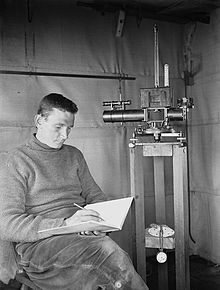George Simpson (meteorologist)

Sir George Clarke Simpson KCB CBE FRS (1878–1965) was a British meteorologist, born in Derby, England.
Biography
George Clarke Simpson was born 2 September 1878 in Derby England, the son of Arthur Simpson, a proprietor of a department store in East Street, and Alice Lambton Clarke. He died 1 January 1965.
Education
Simpson was educated at Derby School, Owens College, Manchester and the University of Göttingen.
Career
In 1902 he visited Lapland to investigate atmospheric electricity. In 1905 he became the first person to lecture in meteorology at a British university when he was appointed lecturer at Manchester University. In 1906, he joined the Indian Meteorological Service as an Imperial Meteorologist at their headquarters in Simla and inspected many of the meteorological stations in India and Burma. In 1910, he was the meteorologist for Robert Falcon Scott's Antarctic Terra Nova Expedition and constructed one of the continent's first weather stations, conducting balloon experiments to test the atmosphere and determine how altitude affects temperature. Simpson recorded the temperature and wind observations at the base camp at Cape Evans. He also held command of this station for several months when Scott and his party left for the journey to the South Pole in November 1911.
Returning from Antarctica after Robert Scott’s death in August 1912, Simpson went back to Simla to re-join the ‘Indian Meteorogical Services’ which had its head office in Kolkata and its branch office in Simla. Whilst in Simla, Sir George Simpson lived at Khud Cottage, today also known as Madan Kunj. It was here at Khud Cottage that Simpson compiled the notes he had made on the Antarctic exploration.

Currently this cottage belongs to Rajeev Madan, and it has been in his family since 1939. Khud Cottage was also the erstwhile residence of the Governor of Burma, during World War II when Burma was occupied by Japan.
When the First World War broke out in 1914, many officers of the Indian Meteorologist Department were drafted for military service. From March to May 1916, Simpson had to perform army service as the meteorological adviser to the British Expeditionary Force in Mesopotamia, which now forms part of southern Iraq. Later, he was called upon to serve as Assistant Secretary to the Board of Munitions and had to leave Simla again.
In 1920 he was appointed Director of the Meteorological Office, London. He went on to be its longest serving Director, retiring in 1938. During his tenure as Director, he was engaged in research work in the fields of atmospheric electricity, ionization, radioactivity and solar radiation. He investigated the causes of lightning and in 1926 established the Simpson wind force scale, a modification of the Beaufort wind force scale which is the current standard scale used worldwide; still called the Beaufort wind force scale.
Simpson was knighted in 1935.
When the Second World War began in 1939, Dr Simpson, recalled from retirement into active service, was asked to take charge of the Kew Observatory. There he continued his research work on the electrical structure of thunderstorms until 1947.
Simpson was awarded honorary doctoral degrees by the universities of Manchester, Sydney and Aberdeen.
Dr Simpson died in 1965 at the age of 87.
Family
Simpson married Dorothy Jane Stephen, daughter of Cecil Stephen, on 23 September 1914. They had four children: Scott Simpson (1915-1981), Professor of Geology at Exeter University; Arthur Simpson (British scientist specialized in the study of plants and sea animals); Oliver Simpson; and Jean Simpson.
Honours
- Hon DSc (Manchester & Sydney)
- Hon LLD (Aberdeen)
- Fellow of the Royal Society, 1915
- Commander of the Order of the British Empire, 1919
- Companion of the Order of the Bath, 1926
- Knight Commander of the Order of the Bath, 1935
- President of the British Meteorological Society, 1940-1942
- The British Antarctic Survey's Ice and Climate Building in Halley Bay, Antarctica (75° 35'S, 26° 40'W), is known as The Simpson Platform, in memory of Sir George Clarke Simpson.
References
- George Clarke Simpson, 1878-1965 by Gordon Manley, in Journal of Glaciology, vol.5, Issue 42, October 1965, pp. 873-874
- George Clarke Simpson at allbio.co.uk
- PBS - "Tragedy at the Pole"
- "Wind force scale"
- Simpson family genealogy
